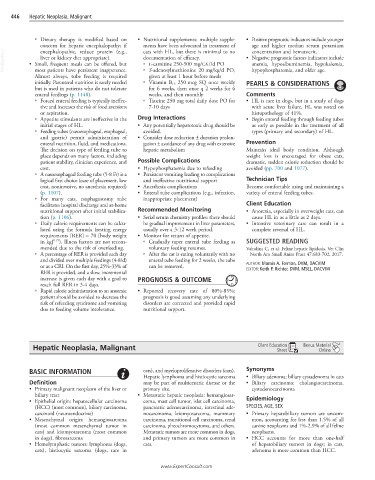Page 914 - Cote clinical veterinary advisor dogs and cats 4th
P. 914
446 Hepatic Neoplasia, Malignant
○ Dietary therapy is modified based on • Nutritional supplements: multiple supple- • Positive prognostic indicators include younger
concern for hepatic encephalopathy; if ments have been advocated in treatment of age and higher median serum potassium
VetBooks.ir • Small, frequent meals can be offered, but documentation of efficacy. • Negative prognostic factors indicators include
cats with HL, but there is minimal to no
encephalopathic, reduce protein (e.g.,
concentration and hematocrit.
liver or kidney diet appropriate).
anemia, hypoalbuminemia, hypokalemia,
○ L-carnitine 250-500 mg/CAT/d PO
most patients have persistent inappetence.
given at least 1 hour before meals
Almost always, tube feeding is required ○ S-adenosylmethionine 20 mg/kg/d PO, hypophosphatemia, and older age.
initially. Parenteral nutrition is rarely needed ○ Vitamin B 12 250 mcg SQ once weekly PEARLS & CONSIDERATIONS
but is used in patients who do not tolerate for 6 weeks, then once q 2 weeks for 6
enteral feedings (p. 1148). weeks, and then monthly Comments
○ Forced enteral feeding is typically ineffec- ○ Taurine 250 mg total daily dose PO for • HL is rare in dogs, but in a study of dogs
tive and increases the risk of food aversions 7-10 days with acute liver failure, HL was noted on
or aspiration. histopathology of 41%.
○ Appetite stimulants are ineffective in the Drug Interactions • Begin enteral feeding through feeding tubes
initial stages of HL. • Any potentially hepatotoxic drug should be as early as possible in the treatment of all
○ Feeding tubes (nasoesophageal, esophageal, avoided. types (primary and secondary) of HL.
and gastric) permit administration of • Consider dose reduction ± duration prolon-
enteral nutrition, fluid, and medications. gation ± avoidance of any drug with extensive Prevention
The decision on type of feeding tube to hepatic metabolism Maintain ideal body condition. Although
place depends on many factors, including weight loss is encouraged for obese cats,
patient stability, clinician experience, and Possible Complications dramatic, sudden calorie reduction should be
cost. • Hypophosphatemia due to refeeding avoided (pp. 700 and 1077).
○ A nasoesophageal feeding tube (5-8 Fr) is a • Persistent vomiting leading to complications
logical first choice (ease of placement, low and ineffective nutritional support Technician Tips
cost, noninvasive, no anesthesia required) • Anesthesia complications Become comfortable using and maintaining a
(p. 1107). • Enteral tube complications (e.g., infection, variety of enteral feeding tubes.
○ For many cats, esophagostomy tube inappropriate placement)
facilitates hospital discharge and at-home Client Education
nutritional support after initial stabiliza- Recommended Monitoring • Anorexia, especially in overweight cats, can
tion (p. 1106). • Serial serum chemistry profiles: there should cause HL in as a little as 2 days.
○ Daily calorie requirements can be calcu- be gradual improvement in liver parameters, • Intensive veterinary care can result in a
lated using the formula (resting energy usually over a 3-12 week period. complete reversal of HL.
requirements [RER] = 70 [body weight • Monitor for return of appetite.
in kg] 0.75 ). Illness factors are not recom- ○ Gradually taper enteral tube feeding as SUGGESTED READING
mended due to the risk of overfeeding. voluntary feeding resumes. Valtolina C, et al: Feline hepatic lipidosis. Vet Clin
○ A percentage of RER is provided each day ○ After the cat is eating voluntarily with no North Am Small Anim Pract 47:683-702, 2017.
and divided over multiple feedings (4-8/d) enteral tube feeding for 2 weeks, the tube
or as a CRI. On the first day, 25%-33% of can be removed. AUTHOR: Marnin A. Forman, DVM, DACVIM
EDITOR: Keith P. Richter, DVM, MSEL, DACVIM
RER is provided, and a slow, incremental
increase is given each day with a goal to PROGNOSIS & OUTCOME
reach full RER in 3-4 days.
○ Rapid caloric administration to an anorexic • Reported recovery rate of 80%-85%;
patient should be avoided to decrease the prognosis is good assuming any underlying
risk of refeeding syndrome and vomiting disorders are corrected and provided rapid
due to feeding volume intolerance. nutritional support.
Hepatic Neoplasia, Malignant Client Education Bonus Material
Online
Sheet
BASIC INFORMATION cats), and myeloproliferative disorders (cats). Synonyms
Hepatic lymphoma and histiocytic sarcoma • Biliary adenoma: biliary cystadenoma in cats
Definition may be part of multicentric disease or the • Biliary carcinoma: cholangiocarcinoma,
• Primary malignant neoplasm of the liver or primary site. cystadenocarcinoma
biliary tract • Metastatic hepatic neoplasia: hemangiosar-
• Epithelial origin: hepatocellular carcinoma coma, mast cell tumor, islet cell carcinoma, Epidemiology
(HCC) (most common), biliary carcinoma, pancreatic adenocarcinoma, intestinal ade- SPECIES, AGE, SEX
carcinoid (neuroendocrine) nocarcinoma, leiomyosarcoma, mammary • Primary hepatobiliary tumors are uncom-
• Mesenchymal origin: hemangiosarcoma carcinoma, transitional cell carcinoma, renal mon, accounting for less than 1.5% of all
(most common mesenchymal tumor in carcinoma, pheochromocytoma, and others. canine neoplasms and 1%-2.9% of all feline
cats) and leiomyosarcoma (most common Metastatic tumors are more common in dogs, neoplasms.
in dogs), fibrosarcoma and primary tumors are more common in • HCC accounts for more than one-half
• Hemolymphatic tumors: lymphoma (dogs, cats. of hepatobiliary tumors in dogs; in cats,
cats), histiocytic sarcoma (dogs, rare in adenoma is more common than HCC.
www.ExpertConsult.com

